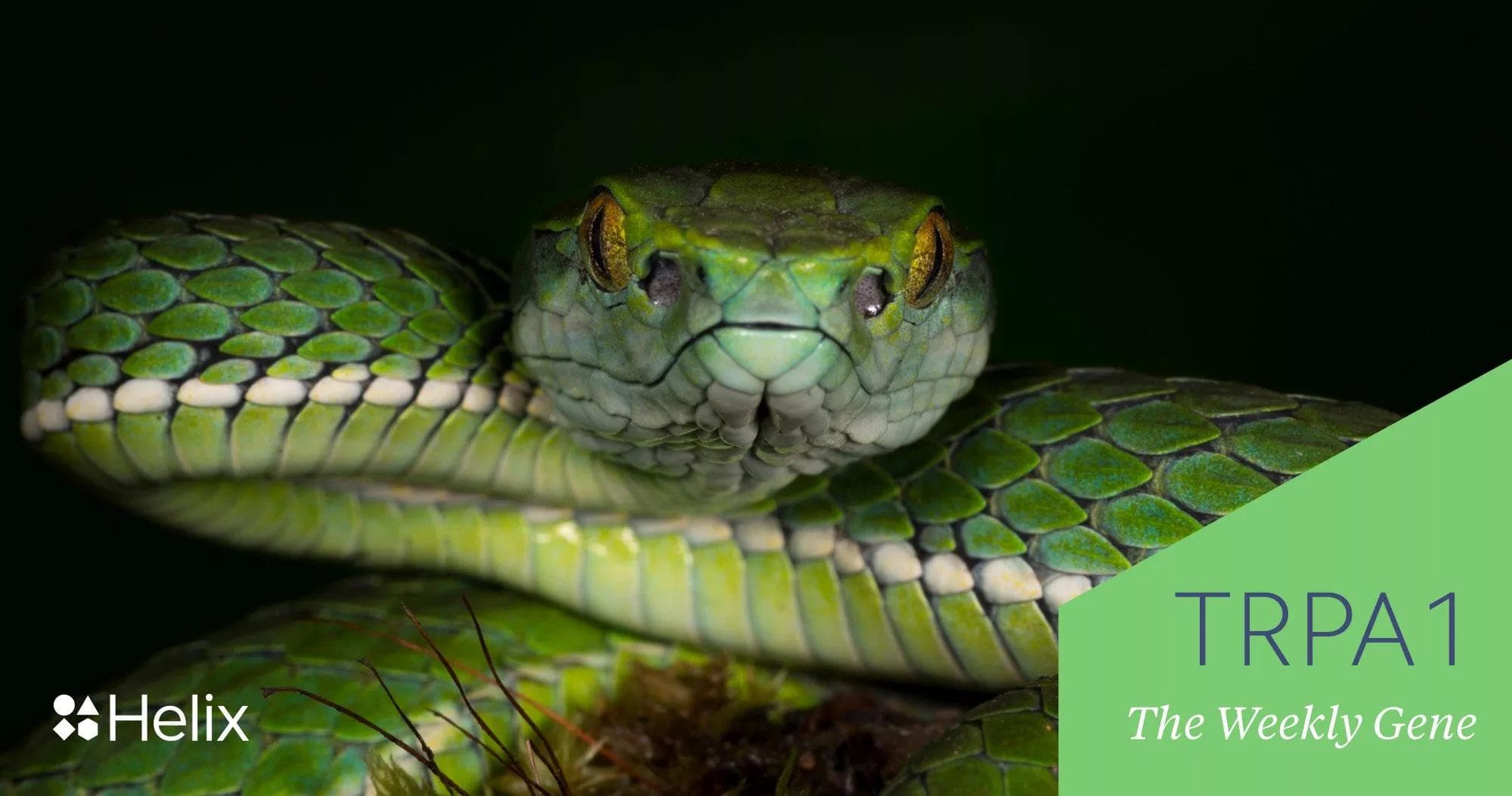This gene helps snakes “see” heat—and helps humans steer clear of harmful substances

Would you be surprised to learn that rattlesnakes and humans share many of the same genes? At the molecular level, both humans and snakes rely on DNA to build life. From our DNA, we gain tools to help us interact with our surrounding environment and, hopefully, to survive it. Some of these molecular tools are so helpful and beneficial that they can be found throughout nature.
One such tool is made from the TRPA1 gene. You wouldn’t know it from the name, but this gene’s product (the TRPA1 protein) has some remarkable properties that have been exploited by nature to give snakes infrared vision—and humans the ability to sense noxious chemicals1.
Evolution has equipped us with several senses that are broadly described as taste, touch, smell, hearing, and sight. But we also have the ability to get more granular than that; we can detect nuanced flavors in our foods and detect subtle changes in our environment. These abilities allow us to find nutrient-rich food while avoiding poison (and predators). In nature, determining what is edible and what isn’t is a complex and critical task. Some foods have nutritional value but may also contain harmful compounds (for example, rotting fruit is high in nutritious energy, but could have deadly bacteria). To help animals overcome these dangers, evolution has developed numerous sensors that help organisms recognize and avoid potentially dangerous chemicals, one of which is TRPA1.
Humans and pit vipers both have the TRPA1 protein, but use them in drastically different ways
TRPA1 is a gene that codes for a protein known as Transient Receptor Potential Ankyrin 1. In humans, this protein rests at the surface of cells where it is used to detect highly reactive chemicals that could potentially damage a cell’s DNA1. TRPA1 is outfitted with special amino acids that can latch onto noxious chemicals. Once it is bound to the noxious agent, TRPA1 sounds the alarm that a dangerous chemical is present which can promote inflammation, coughing, tissue irritation, and more severe responses1,2. How your body responds to these threats can vary depending, in part, on how much of the chemical is detected. For instance, some compounds found in wasabi, cinnamon, raw garlic, and horseradish trigger TRPA1 activation; while they’re all very strong flavors, they clearly don’t elicit such severe responses. On the other hand, chemicals in tear gas also trigger TRPA1 signaling—but in that case, it results in severe aversion (behaviors or actions to avoid the substance)1.
The evolution of such detailed senses took place over millions of years and began in creatures that looked very different from humans. Over time, small changes in the DNA of these early organisms gave rise to newfound abilities like rudimentary vision and the power to detect environmental changes. This evolution eventually led to the world we know today, full of diverse lifeforms that each must interact with their surrounding world. TRPA1 is the product of such evolution, and is not just present in humans. Fruit flies, mosquitos, pit vipers, boa constrictors, nematode worms, humans, and many other animals all have some version of the TRPA1 gene, suggesting that it’s been around for a very long time1-4.
Like humans, fruit flies and other insects use TRPA1 to help them avoid noxious chemicals; however, they also use it as a thermosensor! These animals have evolved slightly different versions of the TRPA1 gene which differ in their DNA sequence. These differences change the protein in key ways that allow them to be used for either heat sensation or chemical detection. Many animals with TRPA1 actually use it for both purposes. In mosquitos, one version is produced near the mouth to detect noxious chemicals, while the other is produced internally to help them detect environmental temperature changes1,2. Having the ability to sense external temperatures can help animals avoid dangerous environments, but it can also be leveraged to help predators and parasites find a warm-blooded meal.
Humans and pit vipers both have the TRPA1 protein, but use them in drastically different ways. Rattlesnakes and other similar snakes have specialized organs below their eyes called loreal pits3,4. These open pockets contain a membrane that is connected to special neurons which are covered in the heat-sensitive version of the TRPA1 protein. The loreal pit neurons extend back to the visual portion of the snake’s brain, allowing them to form a heat map of their environment3,4. In essence, these snakes have a form of infrared vision thanks to the evolution of small changes in their TRPA1 DNA sequence.
The TRPA1 gene has a remarkably diverse range of uses, and in every case it’s intimately involved in helping animals sense the world around them. Small changes in the DNA sequence grant different functions to the protein in different animals. Genes like TRPA1 highlight how similar creatures are at the molecular level—but also shows us how small changes in the DNA can have a dramatic impact on a protein’s function.

1Laursen, Willem J et al. “Species-Specific Temperature Sensitivity of TRPA1.” Temperature: Multidisciplinary Biomedical Journal 2.2 (2015): 214–226. PMC. Web. 13 Mar. 2018.
2Venkatachalam, Kartik, Junjie Luo, and Craig Montell. “Evolutionarily Conserved, Multitasking TRP Channels: Lessons from Worms and Flies.” Handbook of experimental pharmacology 223 (2014): 937–962. PMC. Web. 14 Mar. 2018.
3Gracheva, Elena O. et al. “Molecular Basis of Infrared Detection by Snakes.” Nature 464.7291 (2010): 1006–1011. PMC. Web. 13 Mar. 2018.
4Geng, Jie et al. “Molecular Evolution of the Infrared Sensory Gene TRPA1 in Snakes and Implications for Functional Studies.” Ed. Robert C. Fleischer. PLoS ONE 6.12 (2011): e28644. PMC. Web. 13 Mar. 2018.